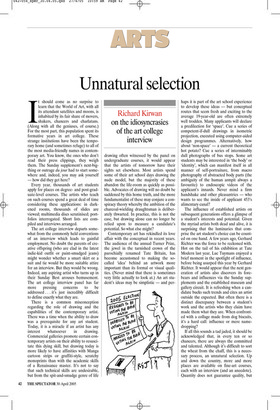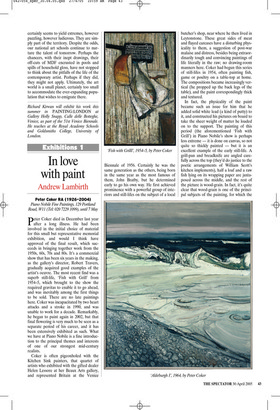Unnatural selection
Richard Kirwan on the idiosyncrasies of the art college interview
It should come as no surprise to learn that the World of Art, with all its attendant satellites and moons, is inhabited by its fair share of movers, shakers, chancers and charlatans. (Along with all the geniuses, of course.) For the most part, this population spent its formative years in art college. These strange institutions have been the temporary home (and sometimes refuge) to all of the most media-friendly names in contemporary art. You know, the ones who don’t read their press clippings, they weigh them. The Sunday supplement’s next-bigthing or outrage du jour had to start somewhere and, indeed, you may ask yourself — how did they get here?
Every year, thousands of art students apply for places on degreeand post-graduate-level courses. The artists who teach on such courses spend a great deal of time considering these applications: in darkened rooms, thousands of slides are viewed; multimedia discs scrutinised; portfolios interrogated. Short lists are compiled and interviews arranged.
The art college interview departs somewhat from the commonly held conventions of an interview which leads to gainful employment. No doubt the parents of creative offspring (who are clad in the latest indie-kid outfit or paint-smudged jeans) might wonder whether a smart skirt or a suit and tie would be more suitable attire for an interview. But they would be wrong. Indeed, any aspiring artist who turns up in their Sunday Best arouses bemusement. The art college interview panel has far more pressing concerns to be addressed ... it’s just incredibly difficult to define exactly what they are.
There is a common misconception regarding the role of drawing and the capabilities of the contemporary artist. There was a time when the ability to draw was a prerequisite for any art student. Today, it is a miracle if an artist has any interest whatsoever in drawing. Commercial galleries promote certain contemporary artists on their ability to resuscitate this dying skill, but drawing today is more likely to have affinities with Manga cartoon strips or graffiti-style, scratchy monoprints than with the academic skills of a Renaissance master. It’s not to say that such technical skills are undesirable, but from the spit-and-smudge genre of life drawing often witnessed by the panel on undergraduate courses, it would appear that the artists of tomorrow have their sights set elsewhere. Most artists spend some of their art school days drawing the nude model, but the majority of these abandon the life-room as quickly as possible. Advocates of drawing will no doubt be saddened by this home truth, and the more fundamentalist of these may conjure a conspiracy theory whereby the ambition of the charcoal-wielding draughtsman is deliberately thwarted. In practice, this is not the case, but drawing alone can no longer be relied upon to measure a candidate’s potential. So what else might?
Contemporary art has rekindled its love affair with the conceptual in recent years. The audience of the annual Turner Prize, the jewel in the tarnished crown of the parochially renamed Tate Britain, has become accustomed to making the socalled ‘idea’ behind an artwork more important than its formal or visual qualities. (Never mind that there is sometimes very little actually to look at.) An art student’s ideas may be simplistic — and per haps it is part of the art school experience to develop these ideas — but conceptual routes that seem fresh and exciting to the average 19-year-old are often extremely well trodden. Many applicants will declare a predilection for ‘space’. Cue a series of competent-if-dull drawings in isometric projection, executed using computer-aided design programmes. Alternatively, how about ‘non-space’ — a current theoretical hot potato? Cue a series of interminably dull photographs of bus stops. Some art students may be interested in ‘the body’ or ‘identity’, which can manifest itself in all manner of self-portraiture, from macro photography of abstracted body parts (the ambiguity of the human armpit always a favourite) to endoscopic videos of the applicant’s innards. Never mind a firm handshake and other pleasantries — who wants to see the inside of applicant 453’s alimentary canal?
The influence of established artists on subsequent generations offers a glimpse of a student’s interests and potential. Given the myriad artists both dead and alive, it is surprising that the luminaries that comprise the art student’s choice can be counted on one hand. A few years ago, Gerhard Richter was the force to be reckoned with. Hot on the tail of his exhibition at Tate Modern last year, Luc Tuymans enjoyed a brief moment in the spotlight of influence, before being usurped this year by Gerhard Richter. It would appear that the next generation of artists also discovers its forebears and influences via the Sunday supplements and the established museum and gallery circuit. It is refreshing when a candidate bucks such trends and cites an artist outside the expected. But often there is a distinct discrepancy between a student’s work and the artists who they claim have made them what they are. When confronted with a collage made from dog biscuits, it’s a hard call: influence or mere namedropping?
If all this sounds a tad jaded, it should be acknowledged that, in every ten or so chancers, there are always the committed and talented. Although it’s difficult to sort the wheat from the chaff, this is a necessary process, an unnatural selection. Up and down the country, more and more places are available on fine-art courses, each with an interview (and an anecdote). Quantity does not guarantee quality, but certainly seems to yield extremes, however puzzling, however ludicrous. They are simply part of the territory. Despite the odds, our national art schools continue to nurture the talent of tomorrow. Perhaps the chancers, with their inept drawings, their off-cuts of MDF encrusted in pools and spills of household gloss, have not stopped to think about the pitfalls of the life of the contemporary artist. Perhaps if they did, they might not apply. Ultimately, the art world is a small planet, certainly too small to accommodate the ever-expanding population that wishes to emigrate there.
Richard Kirwan will exhibit his work this summer in PAINTING:LONDON at Gallery Holly Snapp, Calle delle Botteghe, Venice, as part of the 51st Venice Biennale. He teaches at the Royal Academy Schools and Goldsmiths College, University of London.





















































 Previous page
Previous page